Advertisements
Advertisements
प्रश्न
State two uses of a concave mirror.
Give the uses of a concave mirror.
उत्तर १
Two uses of concave mirror:
(i) It is used as a shaving mirror.
(ii) It is used as reflector in torch, head light of automobiles etc.
उत्तर २
The uses of a concave mirror are
(i) In torches and headlights: The source of light is placed at the focus to obtain a parallel beam of light.
(ii) In floodlights: The source of light is placed just beyond the center of curvature so as to get an intense beam of light.
(iii) Reflecting mirrors for projector lamps: The object is placed at the center of curvature to obtain an image of the same size.
- To collect heat radiations in solar devices: Heat radiations from the sum coming from infinity are brought to focus by a concave mirror in its focal plane.
- Shaving mirror, dentist’s mirror: It produces an erect virtual and highly magnified image of an object placed between its pole and focus.
vi. Solar furnaces: Large concave mirrors are used to concentrate sunlight to produce heat in a solar furnace.
APPEARS IN
संबंधित प्रश्न
A simple microscope is used by watch repairers. Give reason.
A student obtains a sharp image of the distant window (W) of the school laboratory on the screen (S) using the given concave mirror (M) to determine its focal length. Which of the following distances should he measure to get the focal length of the mirror?
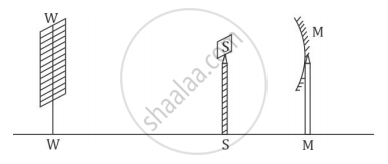
Define the following term in the context of spherical mirrors:- Principal axis
Image formed by a convex ______ is always virtual and smaller in size.
Which type of mirror can form a real image?
A ray of light is incident normally on a plane mirror. What will be the
angle of incidence?
The letter F is placed in front of a plane mirror:
What is the name of the phenomenon involved?
What is the relation between the focal length and radius of curvature of a spherical mirror (concave mirror of convex mirror)? Calculate the focal length of a spherical mirror whose radius of curvature is 25 cm.
When a spherical mirror is held towards the sun and its sharp image is formed on a piece of a carbon paper for some time, a hole is burnt in the carbon paper.
At which point of the spherical mirror the carbon paper is placed?
The shiny outer surface of a hollow sphere of aluminium of radius 50 cm is to be used as a mirror:
State whether this spherical mirror will diverge or converge light rays.
Draw separate diagram for the formation of virtual image of an object by a concave mirror.
State the kind of mirror used
(a) by a dentist, and
(b) as a street light reflector.
An optical device has been given to a student and he determines its focal length by focusing the image of the sun on a screen placed 24 cm from the device on the same side as the sun. Select the correct statement about the device.
(A) Convex mirror of focal length 12 cm
(B) Convex lens of focal length 24 cm
(C) Concave mirror of focal length 24 cm
(D) Convex lens of focal length 12 cm
AB and CD, two spherical mirrors, from parts of a hollow spherical ball with its centre at O as shown in the diagram. If arc AB = `1/2` arc CD, what is the ratio of their focal lengths? State which of the two mirrors will always form virtual image of an object placed in front of it and why.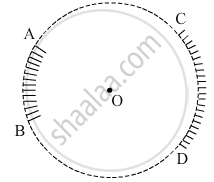
State the types of mirrors used for (i) headlights and (ii) rear view mirror, in cars and motorcycles. Give to justify your answer in each case.
Define the terms pole, principal axis and centre of curvature with reference to a spherical mirror.
Draw suitable diagrams to illustrate the action of (i) concave mirror and (ii) convex mirror on a beam of light incident parallel to the principal axis.
Discuss the position and nature of image formed by a convex mirror when an object is moved from infinity towards the pole of mirror.
What is meant by magnification? Write its expression. What is its sign for the (a) real (b) virtual, image?
The radius of curvature of a convex mirror is 40 cm. Find its focal length.
A point light source is kept in front of a convex mirror at a distance of 40 cm. The focal length of the mirror is 40 cm. Find the position of image.
An object of height 2 cm is placed at a distance of 20 cm in front of a concave mirror of a focal length of 12 cm. Find the position, size, and nature of the image.
Select the correct option:
A concave mirror is made by cutting a portion of a hollow glass sphere of radius 30 cm. The focal length of the concave mirror is:
Define the following term in relation to concave mirror.
Principal axis
Define the term principal focus in case of convex mirror. Draw a convex mirror and show its principal focus and focal length clearly.
Define linear magnification produced by a mirror?
Find the height of the image of a body of height 1.5m in a mirror with a magnification of 1.5.
The boxes in figure (a, b, c) represent mirrors; insert a mirror which will reflect the incident ray as shown in the diagram.
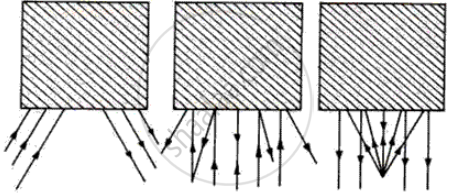
Define the term Pole.
Define the term Focus of a concave mirror.
An object 10 cm high is placed at a distance of 20 cm in front of a spherical mirror of focal length 25 cm. By scale drawing find the nature, position, and magnification of the image in the following case:
Convex mirror
Numerical problem.
The radius of curvature of a spherical mirror is 25 cm. Find its focal length.
A student traces the path of a ray of light passing through a rectangular slab.
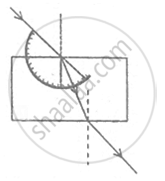 |
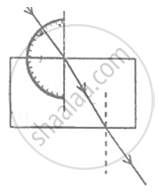 |
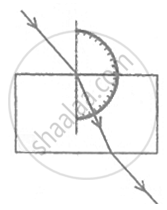 |
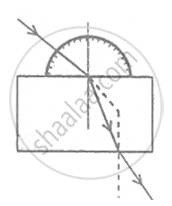 |
For measuring the angle of incidence, he must position the protractor in the manner shown in the figure:
Name the type of mirror used in the following situation:
Side/rear-view mirror of a vehicle
Support your answer with reason.
Name the type of mirror used in the following situation:
Solar furnace
Support your answer with reason.
A shopkeeper wanted to fix a mirror that will give a maximum view of his shop. What type of mirror should he use? Give reason.
The radius of curvature of a spherical mirror is 18 cm. What is the focal length of this mirror?
For a spherical mirror, ______ is true.
